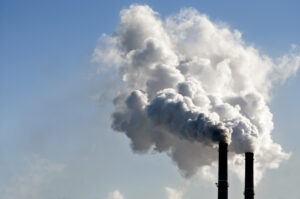August 08, 2019 | Black & Kletz Allergy

Outdoor air pollution is caused by a multitude of gases, chemicals, and particulates. Carbon dioxide is a known gas which is usually a result of burning fossil fuels such as gasoline, natural gas, and coal. The carbon dioxide in the air causes heat to be trapped in the earth’s atmosphere which is known as the “greenhouse effect.” Many scientists feel that this greenhouse effect can lead to global warming. Another greenhouse gas is methane, which may come from gas emitted by livestock, landfills, and the natural gas industry. Chlorofluorocarbons (CFC’s) are another type of greenhouse gas. They were used in aerosol propellants and refrigerants until the 1980’s when they were banned because of they contributed to the breaking down of the Earth’s ozone layer. Other causes of outdoor pollution include sulfur dioxide and particulates. It should be noted that sulfur dioxide is a component of smog and is the primary cause of acid rain. Smog is a visible form of air pollution and is composed of sulfur oxides (e.g., sulfur dioxide), ozone, nitrogen oxides, smoke and other particulates. Smog is usually thought of to be a summer phenomenon. During the summer when the temperatures are warmer and there is more sunlight present, a photochemical reaction of sunlight, nitrogen oxides, and volatile organic compounds (VOC’s) occurs which produces ground-level ozone that is visible. It looks like smoke and in fact, the word “smog” is a combination of the two words “smoke” and “fog.”
Similar to how allergy sufferers monitor the pollen count, individuals interested in monitoring air pollution can follow the air quality index (AQI). The higher the AQI number, the greater the level of air pollution, and thus the greater the health concern. The AQI ranges from 0 to 500 whereby levels between 151 and 500 are “unhealthy.” An AQI number between 0 and 100 is considered to be acceptable by the Environmental Protection Agency (EPA). An AQI value between 101 and 150 may be unhealthy for sensitive (e.g., allergy sufferers, asthmatics, people with other lung diseases and/or heart disease, the elderly, children) individuals. An AQI value of over 300 is hazardous to one’s health. The EPA has assigned a color with each designated specific range of the AQI. The level of health concern, AQI values and colors (e.g., green, yellow, orange, red, purple, maroon), and their meaning are as follows:
| Air Quality Index (AQI) Values |
Levels of Health Concern | Colors |
|---|---|---|
| When the AQI is in this range: | ..air quality conditions are: | …as symbolized by this color: |
| 0 to 50 | Good | Green |
| 51 to 100 | Moderate | Yellow |
| 101 to 150 | Unhealthy for Sensitive Groups | Orange |
| 151 to 200 | Unhealthy | Red |
| 201 to 300 | Very Unhealthy | Purple |
| 301 to 500 | Hazardous | Maroon |
|
Note: Values above 500 are considered Beyond the AQI. Follow recommendations for the Hazardous category. Additional information on reducing exposure to extremely high levels of particle pollution is available here. |
||
Individuals with allergies and asthma are generally more susceptible to the side effects of air pollution. In many cases the particulates, gases, and chemicals can trigger asthma and/or incite nasal and eyes symptoms consistent with allergic rhinitis and allergic conjunctivitis. Others are affected by air pollution as a direct irritant-type nonallergic reaction. The most common symptoms caused by air pollution may include irritated eyes, burning of the eyes, red eyes, watery eyes, runny nose, burning of the nose, sore throat, fatigue, headaches, coughing chest tightness, chest pain, and/or shortness of breath.
There are some preventive measures as well as recommended treatments that should be undertaken when the AQI values rise. In consultation with one of our board certified allergists at Black & Kletz Allergy, we discuss these issues as well as others in order to prevent untoward and unnecessary reactions to all types of pollution.
The allergists at Black & Kletz Allergy have been diagnosing and treating allergies, asthma, sinus conditions, and immunological disorders for more than 50 years. We have been a proponent of a clean environment for a long time and Dr. Kletz has done volunteer work for the American Lung Association. Black & Kletz Allergy has 3 convenient locations in the Washington, DC metro area with offices in Washington, DC, McLean, VA (Tysons Corner, VA), and Manassas, VA. We offer on-site parking at each location and the Washington, DC and McLean offices are Metro accessible. There is a free shuttle that runs between our McLean, VA office and the Spring Hill metro station on the silver line. Please call us today to make an appointment at the office of your choice. Alternatively, you can click Request an Appointment and we will respond within 24 hours by the next business day. The allergists at Black & Kletz Allergy pride themselves in the delivery of the highest quality allergy care in the Washington, DC metropolitan area. In addition, we strive to provide excellent customer service in a friendly and affable environment.












